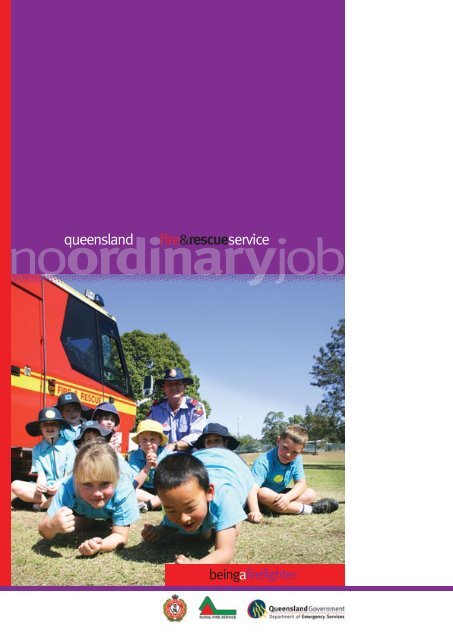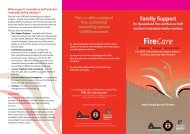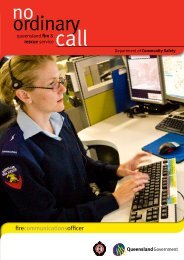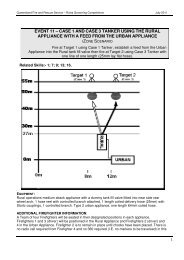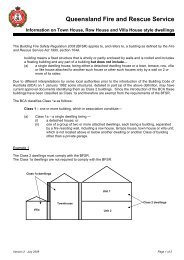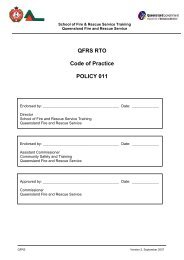Book 1.indd - Queensland Fire and Rescue Service
Book 1.indd - Queensland Fire and Rescue Service
Book 1.indd - Queensland Fire and Rescue Service
- No tags were found...
Create successful ePaper yourself
Turn your PDF publications into a flip-book with our unique Google optimized e-Paper software.
about department of emergency services<strong>Queensl<strong>and</strong></strong>’s Department of Emergency <strong>Service</strong>s (DES) is unique inAustralia. The Department provides services covering all phases ofemergency <strong>and</strong> disaster management - prevention, preparedness,response <strong>and</strong> recovery.DES employs approximately 7,100 full time <strong>and</strong> part timeemployees, <strong>and</strong> is supported by more than 88,000 volunteersacross <strong>Queensl<strong>and</strong></strong>.The Department’s vision is to create a safer community <strong>and</strong> betterquality of life in <strong>Queensl<strong>and</strong></strong> through world class emergency <strong>and</strong>disaster services.The three operational divisions of DES are <strong>Queensl<strong>and</strong></strong> <strong>Fire</strong> <strong>and</strong><strong>Rescue</strong> <strong>Service</strong> (QFRS), <strong>Queensl<strong>and</strong></strong> Ambulance <strong>Service</strong> (QAS) <strong>and</strong>Emergency Management <strong>Queensl<strong>and</strong></strong> (EMQ).about queensl<strong>and</strong> fire <strong>and</strong> rescue serviceQFRS provides fire <strong>and</strong> rescue services to the entire community of<strong>Queensl<strong>and</strong></strong> through approximately 2,000 permanent firefighters,2,000 Auxiliary firefighters <strong>and</strong> over 36,000 Rural <strong>Fire</strong> <strong>Service</strong>volunteers.These services are aimed at protecting people, property <strong>and</strong>the environment through the delivery of community safety<strong>and</strong> awareness programs, response capability <strong>and</strong> capacity(preparedness), <strong>and</strong> incident response <strong>and</strong> recovery.QFRS operates under the <strong>Fire</strong> <strong>and</strong> <strong>Rescue</strong> <strong>Service</strong> Act 1990.being a firefighter | www.fire.qld.gov.au01
firefighting -it’s more than just fighting firesThe responsibilities of firefighters are many <strong>and</strong> diverse - firefightersdon’t just fight fires.A main emphasis of a firefighter’s job is on the prevention of fires.As well as educating the community on fire, its risks, management<strong>and</strong> prevention, firefighters also conduct safety inspections ofcommercial <strong>and</strong> industrial buildings <strong>and</strong> licensed premises.Other community education programs that firefighters areinvolved in include Fight <strong>Fire</strong> Fascination (FFF), Road Awareness<strong>and</strong> Accident Prevention (RAAP) <strong>and</strong> Operation SafeHome.In addition, firefighters conduct rescue operations. These includeroad accident, swift water <strong>and</strong> vertical rescues, <strong>and</strong> Urban Search<strong>and</strong> <strong>Rescue</strong> (USAR), encompassing trench, confined space <strong>and</strong>building collapse rescues.Disaster response is also an integral part of a firefighter’s job.Furthermore, firefighters are required to undertake ongoingtraining, skill maintenance <strong>and</strong> study towards career progression.More mundane tasks associated with the job include stationmaintenance <strong>and</strong> cleaning.vicki shailerStation Officer, Bundaberg <strong>Fire</strong> StationI commenced as an Auxiliary firefighter in 1993 in Bundaberg,where I’ve lived most of my life. I became a permanent firefighterin 1997.I chose firefighting as a job because it provides great careeropportunities. I also like the physical side of the job, working in ateam environment <strong>and</strong> the variety the job offers.When I started, I was very excited <strong>and</strong> proud to be a firefighter. Icouldn’t wait for the alarm to sound so I could turn out to my firstjob.The <strong>Service</strong> has changed a lot over the years. We have betterequipment <strong>and</strong> trucks <strong>and</strong> we are certainly more proactive inthe community, especially with our education <strong>and</strong> awarenessprograms. We also specialise in rescue operations.With firefighting, every day is a challenge. You never know whatthe next job will be, where it will take you or, at times, when youwill be getting home.Every day is different <strong>and</strong> every job is different.I enjoy working with children, their visits to the station <strong>and</strong>educating them on fire safety. I see their faces light up when theysee the big red truck <strong>and</strong> flashing lights.being a firefighter | www.fire.qld.gov.auI also like working for, <strong>and</strong> being part of, the community.For anyone who is considering a career as a firefighter I’d say, Gofor it! Be positive, work hard to achieve your goal, <strong>and</strong> give it morethan 100%. If you do, at the end of the day, you will end up withthe best career ever.02“With firefighting, every day is a challenge.”VICKI SHAILER - bundaberg
do you have what it takes?A career as a firefighter can be very rewarding but it is not foreveryone. <strong>Fire</strong>fighting is an extremely technical <strong>and</strong> multi-skilledactivity, vital to the welfare of the community. As such, it is a highlyvalued profession.But being a firefighter is tough.If you’re considering becoming a firefighter, ask yourself thesequestions:Do you like working as part of a team?Are you able to keep a level head in stressful situations?Are you willing to carry out orders <strong>and</strong> follow directions?Do you have a genuine willingness to contribute to thecommunity?Are you physically fit?Do you enjoy working with people from diverse backgrounds?Can you work efficiently <strong>and</strong> solve problems in a timely manner?Do you enjoy shift work?Are you a good communicator?Do you possess a high level of personal integrity?Are you committed to maintaining <strong>and</strong> developing your skills?Can you adapt well to new <strong>and</strong> unpredictable situations?If you’ve truthfully answered yes to all these questions <strong>and</strong> youhave the passion <strong>and</strong> drive to become a firefighter, your journeyhas just begun.The next step is to become familiar with the extensive QFRSfirefighter recruitment process <strong>and</strong> ensure you have therequirements for application.ian amesStation Officer, CapalabaThe fire service is everything I had hoped for <strong>and</strong> more.We responded to plenty of fires in the early days then we foundthat we were involved in more <strong>and</strong> more motor vehicle accidentrescues.When someone is trapped, the look in their eyes when you explainto them that you are going to get them out is unforgettable. Theyput so much trust <strong>and</strong> hope in you. It is a real achievement to getthem out quickly <strong>and</strong> safely.Over the years, I have been involved in numerous rescues - bothvehicle accident related <strong>and</strong> others.The Boondall bus crash in October 1994, remains <strong>Queensl<strong>and</strong></strong>’sworst ever traffic accident on record. We rescued dozens of peoplefrom the wreckage. We also had to extricate 12 fatal victims fromwithin <strong>and</strong> under the bus.The fire at Gateway Motel on Ann Street in Brisbane was also amassive operation. A hydraulic platform was used to rescue 51people from the third floor. This remains the largest number everto be rescued from a fire in <strong>Queensl<strong>and</strong></strong>.There is so much satisfaction in rescuing people from situationsthat would normally seem so hopeless.“They put so much trust <strong>and</strong> hope in you.”IAN AMES - capalababeing a firefighter | www.fire.qld.gov.au03
eing a firefighter | www.fire.qld.gov.aucareers <strong>and</strong> trainingThe <strong>Queensl<strong>and</strong></strong> <strong>Fire</strong> <strong>and</strong> <strong>Rescue</strong> <strong>Service</strong> is committed to training<strong>and</strong> education as a long term investment aimed at maintaining ahighly skilled workforce.An essential component of a firefighter’s job is to maintain skills<strong>and</strong> undertake ongoing training.It is through quality training that firefighters develop the confidence,skills, knowledge <strong>and</strong> abilities to combat <strong>and</strong> manage increasinglycomplex emergency situations.People considering firefighting as a career must note that ALLfirefighters undertake continuous training <strong>and</strong> studies.Commencing at initial appointment <strong>and</strong> continuing throughouttheir career, a firefighter must undertake a multitude of trainingprograms, activities <strong>and</strong> assessments, to ensure their skills remainat an optimum level.the professional development unitThe School of <strong>Fire</strong> <strong>and</strong> <strong>Rescue</strong> <strong>Service</strong>s Training, situated at the<strong>Queensl<strong>and</strong></strong> Combined Emergency <strong>Service</strong>s Academy (QCESA) inBrisbane, is responsible for implementing training.QCESA’s focus is on the professional firefighter. As well asoverseeing the strategic direction of education <strong>and</strong> training, QCESAdevelops, conducts, supervises <strong>and</strong> evaluates a range of bestpractice programs designed to ensure <strong>Queensl<strong>and</strong></strong>’s firefighterknowledge <strong>and</strong> skills compare with the best in the world.QCESA is a Registered Training Organisation which means itscurriculum is accredited <strong>and</strong> audited by the <strong>Queensl<strong>and</strong></strong> Departmentof Education, Training <strong>and</strong> the Arts (DETA). Ten programs areimplemented through QCESA’s three campuses - Main Campus,Live <strong>Fire</strong> Campus <strong>and</strong> Online Campus.recruit trainingDuring the recruit course, training generally occurs between 8.00am<strong>and</strong> 5.00pm, however some night exercises are also included in theprogram.<strong>Fire</strong>fighter recruits are required to undertake a recruit trainingcourse at QCESA in Brisbane.The recruit training course consists of 78 days of training.Training includes the use of a wide range of firefighting equipment,driving instruction <strong>and</strong> the use of self-contained breathingapparatus. It also encompasses vertical rescue, Road Accident<strong>Rescue</strong> <strong>and</strong> Occupational Health & Safety modules.In this program recruits complete PUA20701 Certificate II in PublicSafety (<strong>Fire</strong>fighting <strong>and</strong> Emergency Operations), <strong>and</strong> a number ofunits from PUA30601 Certificate III in Public Safety (<strong>Fire</strong>fighting <strong>and</strong>Emergency Operations). This training is part of the Diploma of <strong>Fire</strong><strong>and</strong> <strong>Rescue</strong> Operations.further trainingAt the completion of the initial recruit training, all firefightersenroll in a Distance Education program which uses self-pacedinstructional materials.This program is part of the Diploma in <strong>Fire</strong> <strong>and</strong> <strong>Rescue</strong> Operations.The program, supported by peers <strong>and</strong> mentors, Area Directors <strong>and</strong>regional Training Officers, consists of a series of steps. Each steprequires modules to be completed, <strong>and</strong> progression is dependanton each step being completed within a 12 months.Each module enhances knowledge <strong>and</strong> skills in subject areas,exp<strong>and</strong>ing on the foundation acquired in previous modules.Completion of this course of study is compulsory.<strong>Fire</strong>fighters may then choose to maintain this level of competenceor undertake further training <strong>and</strong> study to prepare for supervisoryduties <strong>and</strong> Officer ranks.Details of the compulsory training are provided in the followingflowchart below:Year 1POST RECRUIT COURSEYear 2Year 3RECRUIT COURSE12 units from PUA20701successfully completedFIR302A Suppress Urban <strong>Fire</strong>(remainder)FIR303 A Suppress WildfireCMOO1B Communicate in the WorkplaceCompletion of Certificate IIIQFR503 Apply scientific practicesin firefighting <strong>and</strong> rescue operationsRegional Face to Face Practical Assessment QSTEP1-2QFR513 Assess combustion process <strong>and</strong>fire risk control <strong>and</strong> suppressionQFR504 Assess building constructionQFR510 Combat specific types offirefighting incidents - <strong>Book</strong> 1QFR510 Combat specific types offirefighting incidents - <strong>Book</strong> 2QFR510 Combat specific types offirefighting incidents - <strong>Book</strong> 3QFR512 Demonstrate structuralfirefighting techniquesPUASAR003A Undertake technical rescueRegional Face to Face Practical Assessment QSTEP2-3QFS514 Assess building fire protectionsystems - <strong>Book</strong> 1QFS514 Assess building fire protectionsystems - <strong>Book</strong> 1QFR519 Assess hazards at processing<strong>and</strong> storage sitesPUAFIR205A Respond to aviationincidents (specialist)BSBCMN410A Coordinate implementationof customer service strategiesTDTL597C Apply conflict / grievanceresolution strategiesQFR521 Respond to maritime incidentsCompletion of Diploma in <strong>Fire</strong> <strong>and</strong> <strong>Rescue</strong> Operations04“I work with a group of men <strong>and</strong> women who at the drop of a hat respondto emergencies to help other people.” SIMON JOHNSTONE- brisbane
ank structureThe rank structure of the <strong>Queensl<strong>and</strong></strong> <strong>Fire</strong> <strong>and</strong> <strong>Rescue</strong> <strong>Service</strong> isas follows:4th Class <strong>Fire</strong>fighter3rd Class <strong>Fire</strong>fighter2nd Class <strong>Fire</strong>fighter1st Class <strong>Fire</strong>fighterSenior <strong>Fire</strong>fighterLeading <strong>Fire</strong>fighterStation OfficerInspectorSuperintendentChief SuperintendentAssistant CommissionerDeputy CommissionerCommissionerrank progressionProgression to 1st Class <strong>Fire</strong>fighter is compulsory. Level progressionrequires the completion of 12 months service at each level <strong>and</strong> isdependent on the following:Completion of pre-defined components of the Diploma of<strong>Fire</strong> <strong>and</strong> <strong>Rescue</strong> Operations;Ongoing satisfactory performance;Competent delivery of operational skill requirements;Achievement of necessary accreditations; <strong>and</strong>Satisfactory achievement levels for formal examinations.After completing the Diploma of <strong>Fire</strong> <strong>and</strong> <strong>Rescue</strong> Operations,employees may undertake the Diploma of Public Safety - <strong>Fire</strong>fighterManagement. This is an optional two year Diploma.After the first year of the Diploma of Public Safety - <strong>Fire</strong>fighterManagement, employees may be eligible for promotion to theSenior <strong>Fire</strong>fighter level.On successful completion of the entire Diploma, while waitingappointment as a Station Officer, employees may be appointed asa Leading <strong>Fire</strong>fighter.ross cutugnoStation Officer, Kemp Place <strong>Fire</strong> Station, BrisbaneI enjoy coming to work for lots of different reasons - friendships,being able to help members of the public in their times of need,<strong>and</strong> the buzz of adrenalin when faced with danger.The challenge of responding to the bells <strong>and</strong> the diverse amount ofoperational scenarios, are always exciting.If I had my time all over again, I wouldn’t change a thing. Being afirefighter has taught me so much about life <strong>and</strong> the challengesthat each <strong>and</strong> every one of us face.In particular, one experience early on in my career st<strong>and</strong>s out asbeing a real eye opener.In 1986, we responded to an explosion at the Mail Exchange atRoma Street. Initially, it was thought to be an act of terrorism.The scene was chaotic <strong>and</strong> there were a number of badly injuredpeople located within the explosion zone.The experience taught me that the job of a firefighter is real <strong>and</strong>serious. We are dealing with people’s lives <strong>and</strong> that’s certainlynothing to be taken lightly.“Being a firefighter has taught me so much about life.”ROSS CUTUNGO - brisbanebeing a firefighter | www.fire.qld.gov.au05
eing a firefighter | www.fire.qld.gov.au06“I have met many people from all walks of life - both in <strong>and</strong> out of the job.”TAI MOORE - cairns
firefighter hours of work<strong>Fire</strong>fighters employed at 24 hour stations work continuous shift rosters that consist of two consecutive day shifts followed by two consecutivenight shifts. Day shifts are 10 hours in duration. Night shifts are 14 hours in duration.Other stations may not be staffed by permanent firefighters on a 24 hour basis.wages<strong>Fire</strong>fighters employed by QFRS are covered by the <strong>Queensl<strong>and</strong></strong> <strong>Fire</strong> <strong>Service</strong> Interim Award - State. The Award should be referred to forcomprehensive details of terms <strong>and</strong> conditions of employment.In brief, base wages are as follows:wage rates (effective 01/07/07)RankBASERATEWEEKENDSHIFTNIGHTSHIFT38 hourALLOWANCETOTAL4th Class <strong>Fire</strong>fighter$1230.30$263.70$79.40$82.80$1656.203rd Class <strong>Fire</strong>fighter$1372.00$294.00$88.50$92.30$1846.802nd Class <strong>Fire</strong>fighter$1490.50$319.40$96.10$100.30$2006.301st Class <strong>Fire</strong>fighter$1608.00$344.60$103.70$108.20$2164.50Senior <strong>Fire</strong>fighter$1701.20$364.60$109.70$114.50$2290.00Leading <strong>Fire</strong>fighter$1813.80$388.70$117.00$122.10$2441.60leave<strong>Fire</strong>fighters work an average of 42 hours per week. Wages for firefighters are based on a 38 hour week. For the extra four hours per week,firefighters are paid an allowance (38 hour allowance) for two hours <strong>and</strong> accrue an extra two hours annual leave.Annual leave is usually taken in accordance with a rotating roster. Leave taken outside these times must be applied for <strong>and</strong> approved inadvance.TypeAnnual Leave <strong>and</strong> Accrued HoursLong <strong>Service</strong> LeaveSick LeaveAnnual Accrual312 hours per annum1.3 weeks (eligible to be taken after 10 years service)80 hours (8 shifts)Recognition of Prior <strong>Service</strong> (RPS) for leave purposes may apply to ex-employees of interstate <strong>Fire</strong> <strong>Service</strong>s, State <strong>and</strong> Federal Public <strong>Service</strong>employees <strong>and</strong> ex-Defence employees. RPS applies to Long <strong>Service</strong> <strong>and</strong> Sick Leave only.superannuation<strong>Fire</strong>fighters are required to contribute to QSuper, the superannuation scheme for <strong>Queensl<strong>and</strong></strong> Public Sector employees. In this scheme, boththe employee <strong>and</strong> employer make contributions.probationAppointment as a recruit firefighter is subject to a period of 12 months probation. Job performance is continually assessed during this time.uniformsUniforms not only aid in protection at incidents but also assist in building a rapport with the community. Uniforms must therefore be wornat all times while on duty.Uniform items <strong>and</strong> protective clothing are provided when employees commence Recruit Training. They are replaced on an “as required”basis.being a firefighter | www.fire.qld.gov.au07
eing a firefighter | www.fire.qld.gov.au08“I wanted to do something for the community.”THEO GIESEN - north coast region
noordinaryordinaryjob<strong>Queensl<strong>and</strong></strong> <strong>Fire</strong> & <strong>Rescue</strong> <strong>Service</strong>GPO Box 1425 Brisbane Q 4001T 131 304www.fire.qld.gov.au


